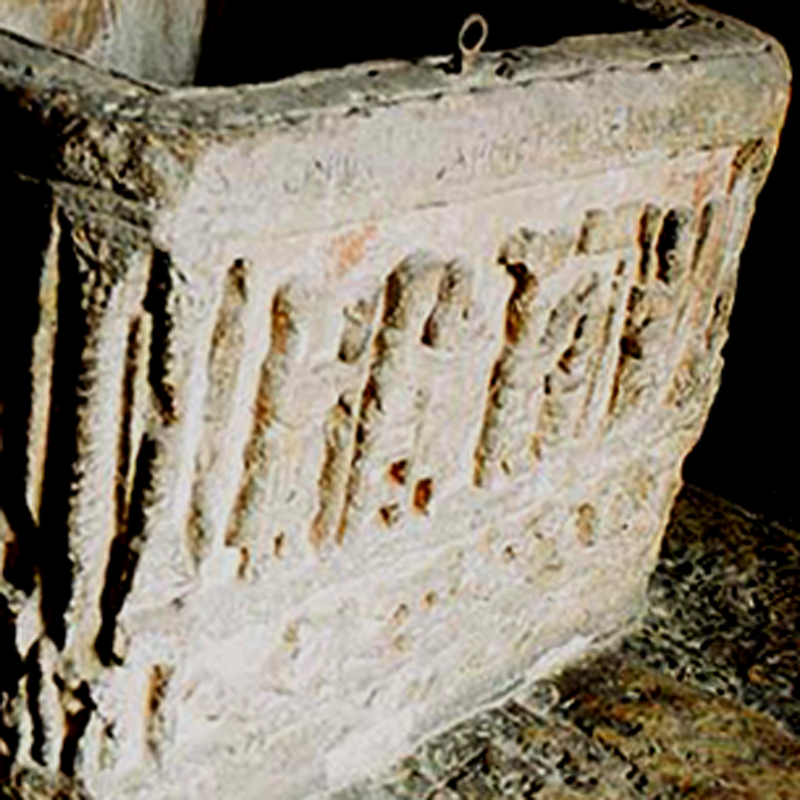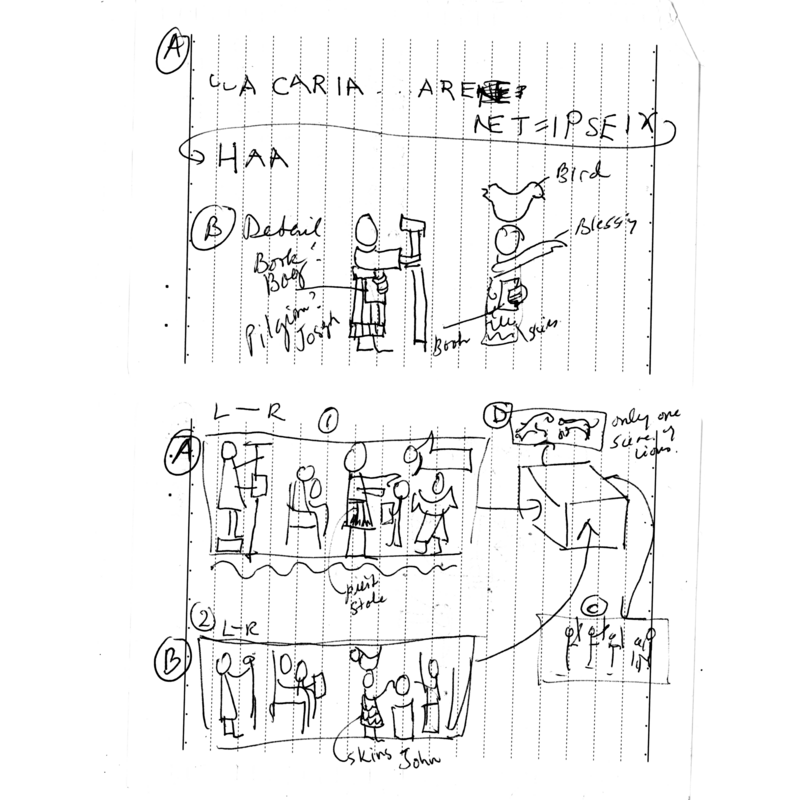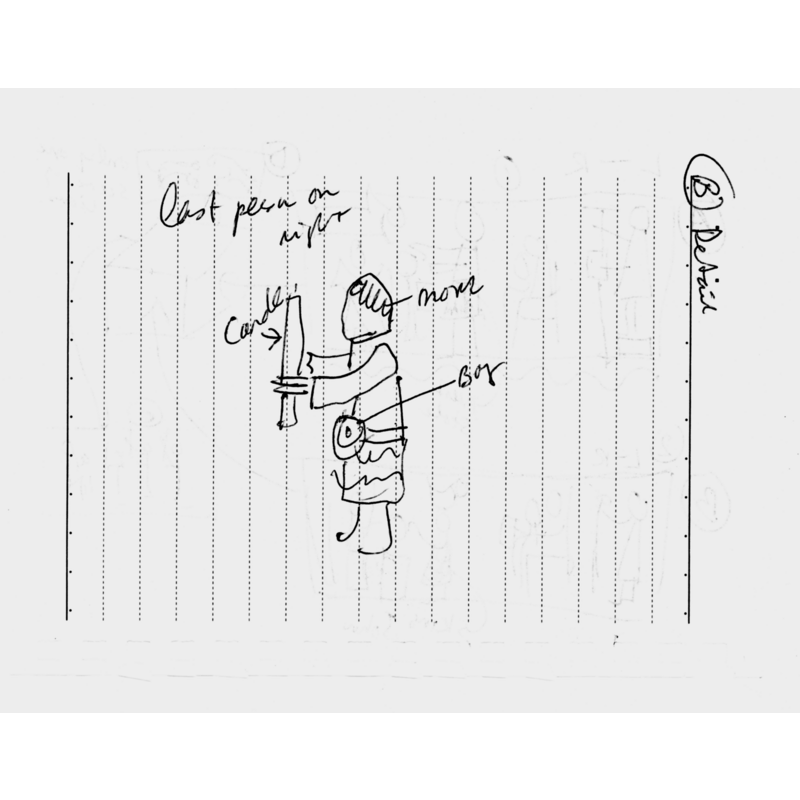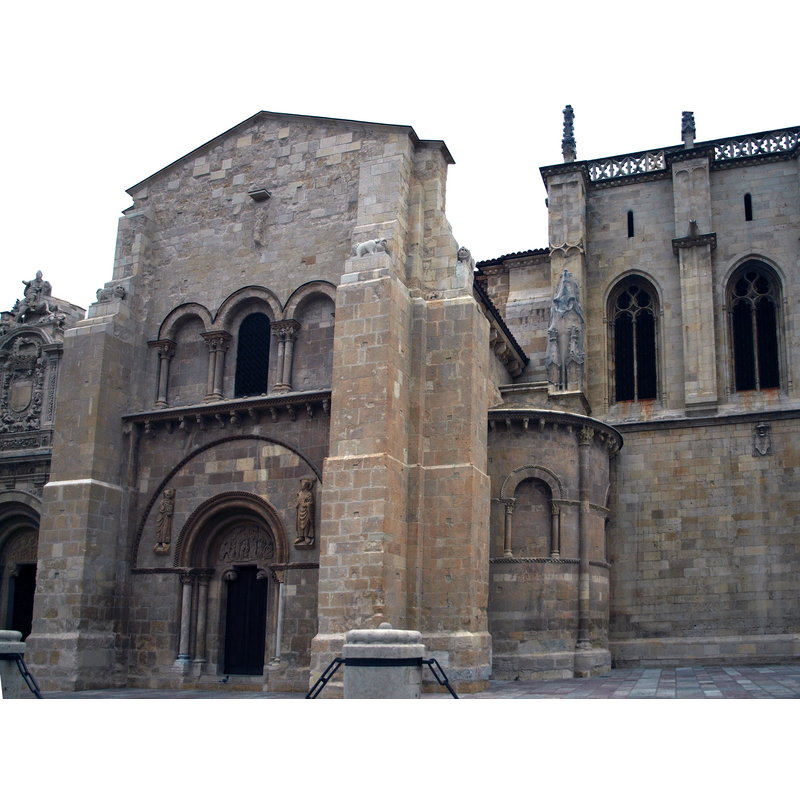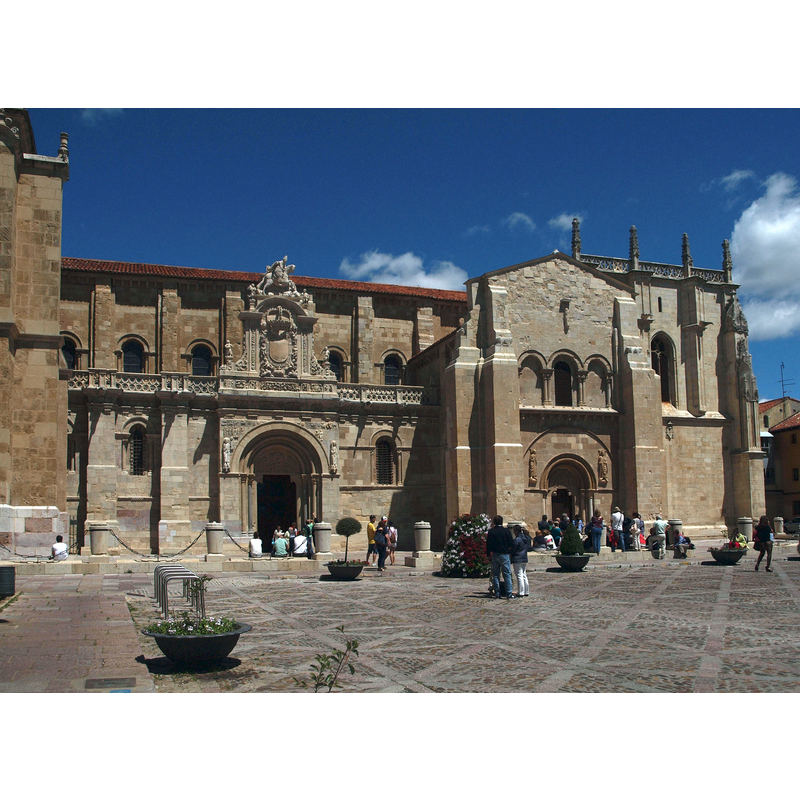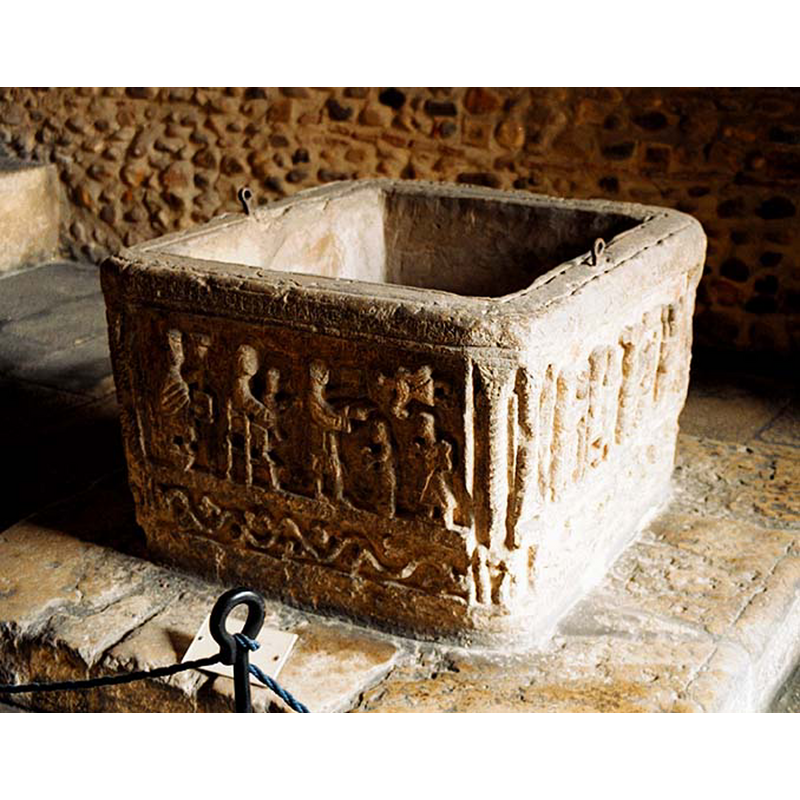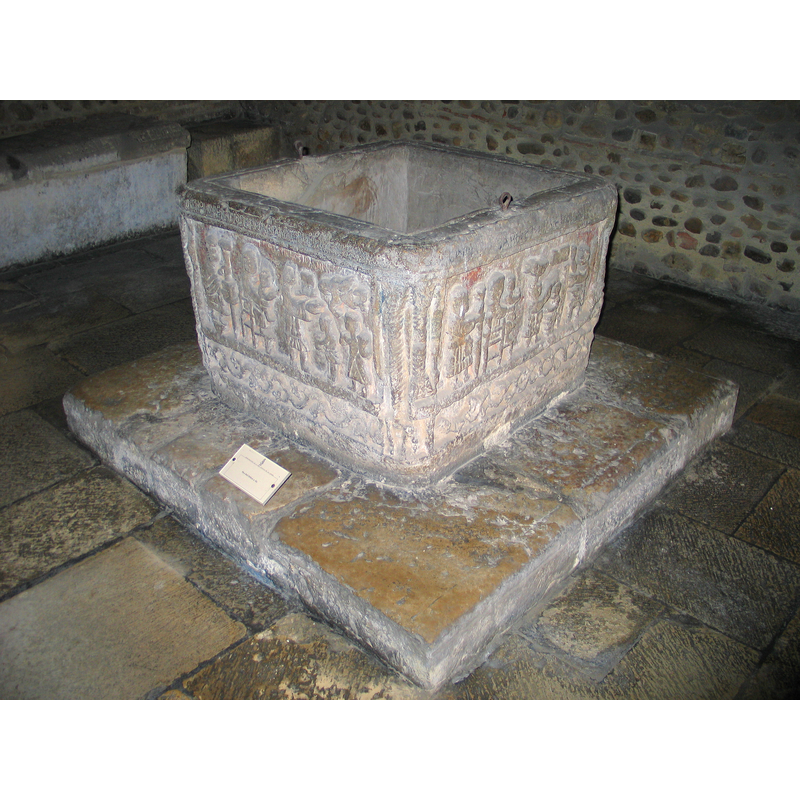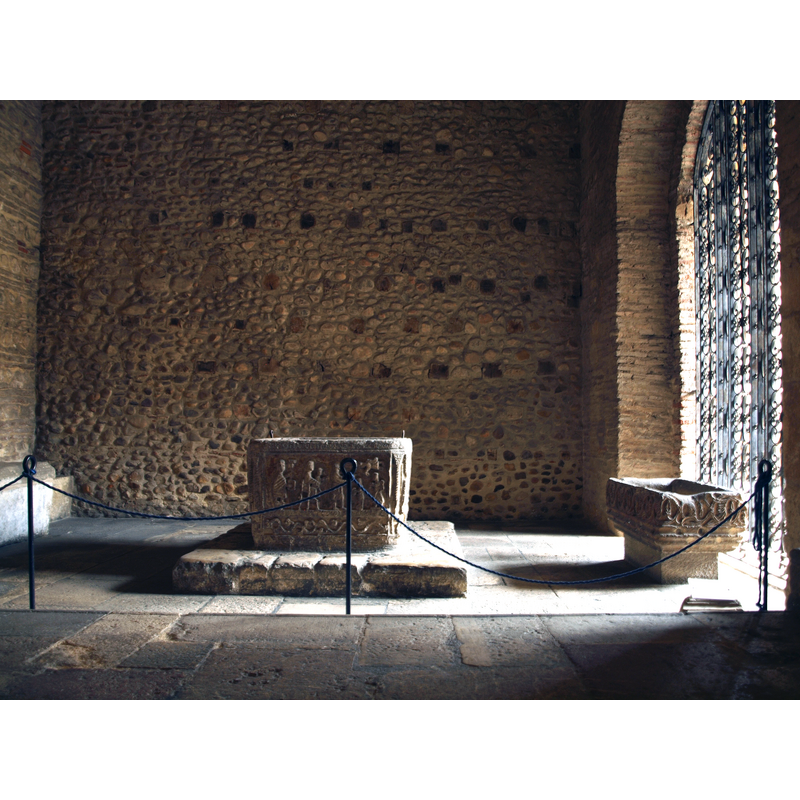Leon No. 2 / León
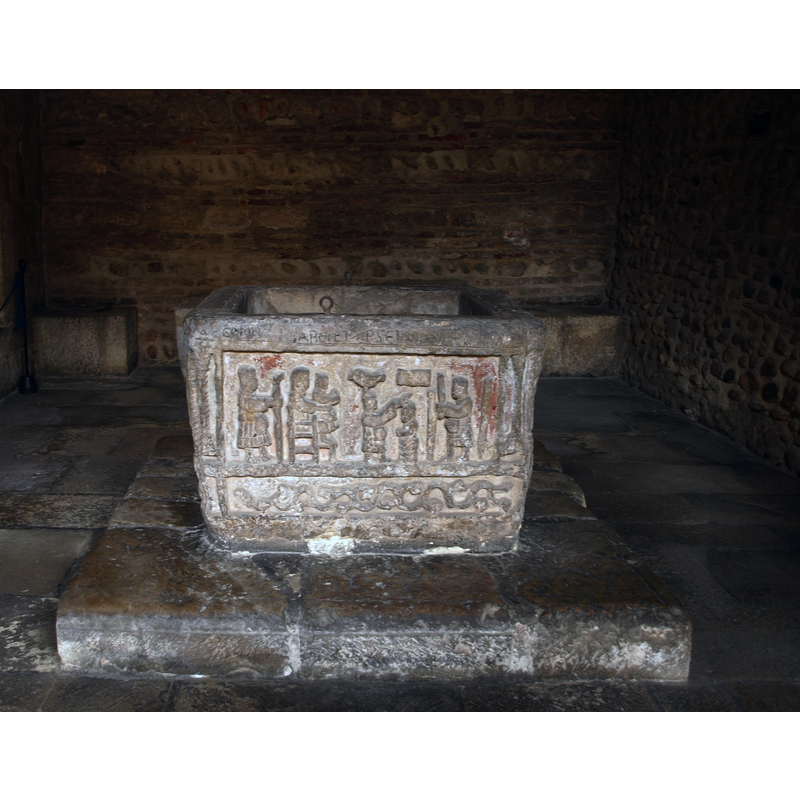
Image copyright © Mikel Unanue, 2019
Image and permission received from the author (e-mail of 9 June 2019)
Results: 27 records
B01: Virgin Mary - Madonna and Christ-child - with Joseph standing behind
Scene Description: East side: the three figures face a baptismal/bath scene on the same side
Copyright Statement: Image copyright © Mikel Unanue, 2019
Image Source: edited detail of a digital photograph taken 28 June 2014 by Mikel Unanue
Copyright Instructions: Image and permission received from the author (e-mail of 9 June 2019)
B02: New Testament - public life of Christ - baptism of Christ - John the Baptist - in priestly vestments
B03: Apostle or saint - St. John the Baptist - with family
B04: Apostle or saint - St. John the Baptist - baptism of unidentified person
Scene Description: East side?: has been identified alternatively as the Baptism of Christ in the presence of Mary on one of the sides of the square font. John is wearing a stole [the words "Johannes Ba...sta" appears in the legend above]
Copyright Statement: Image copyright © Mikel Unanue, 2019
Image Source: edited detail of a digital photograph taken 28 June 2014 by Mikel Unanue
Copyright Instructions: Image and permission received from the author (e-mail of 9 June 2019)
B05: New Testament - Childhood and youth of Christ - three Wise Men - journey of the Wise men - arriving on horseback - holding palms - with attendant
B07: animal - mammal - lion - facing each other - 2 - holding wreath
view of basin - detail
view of basin - detail
view of basin - detail
view of basin - detail
view of basin - east side
view of basin - iconographic program - detail
view of basin - iconographic program - detail
view of basin - iconographic program - detail
view of basin - north side
view of basin - north side
view of basin - south side
view of basin - south side
view of basin - west side
view of basin - west side
view of church exterior - west façade
view of church exterior - west view
view of font
view of font
view of font - east side
INFORMATION
FontID: 00009LEO
Object Type: Baptismal Font1
Church/Chapel: San Isidoro de León [formerly Iglesia Parroquial de San Froilán y San Pedro]
Church Patron Saints: St. Isidore of Seville
Church Location: Plaza de San Isidoro, 4, 24003 León, Spain -- Tel.: +34 987 87 61 61
Country Name: Spain
Location: León, Castilla y León
Directions to Site: Located in León capital, in the historic centre
Ecclesiastic Region: Diócesis de León
Font Location in Church: In the Panteón de San Isidoro, capilla de los Salazares [until the late 1950s it was in its original position at the W end of the S aisle of the church]
Century and Period: 12th century, Romanesque
Cognate Fonts: cf. Index entry for Teverga, a font that may have similarities with this one] [cf. FontNotes]
Font Notes:
Click to view
This font may have been originally from the old church of San Juan Bautista y San Pelayo. Usually referred to as "Visigothic", a dating supported by Assas (1872), who gives 630 A.D., and repeated thereafter in many sources despite its exagerated claim. The quadrangular font is claimed by some authors to contain four scenes: Adoration of the Shepherds, Adoration of the Magi, Flight to Egypt and Baptism of Christ in the presence of the Virgin all on three of the sides, while the fourth shows two lions face to face (Enríquez de Salamanca, 1990) and (Gómez-Moreno, 1979). The description in Viñayo Gonzalez (1987 c1979 is more detailed but not so clear with respect to the scenes. There are inscriptions on the upper part of each of the sides, except the one with the lions, but the inscriptions are either eroded or broken up (Viñayo González, 1987 c1979). Porter (1969 c1928) writes: "the iconography [on this font] is strange and savours of a time when Romanesque traditions had not yet penetrated into the peninsula". His description of the sides of the font is confusing: he refers twice to "the fourth face" with different scenes and describes the two long sides as south face and east face. Parker (ibid.) describes the scenes thus: 1)"On the south face is seated the Virgin, bolt/upright as in the frescoed figure of San Miguel de Linio, holding the Christ/Child in her lap. Behind Joseph stands on a stool, holding a book and a crozier. In front of the Virgin, John the Baptist baptizes Christ. Both the Baptist and the Saviour hold books; the Christ in small scale, but has a beard; two angels behind [...]"; 2)"on the east face [...] again we have the Virgin seated on a throne with a foot/stool, holding the Christ/Child. Behind her stands a figure with crozier and book, possibly in this case not Joseph, but the earthly priest. Another priest, on whose head perches the dove of the Holy Spirit, baptizes a bearded man in a font [...]"; 3)"the fourth face shows four persons in procession, converts I suppose, advancing towards a cross set upright in the ground. Each carries what I take to be a cross, the first is on horse/back, the last seems to me to carry a child"; 4)"On the fourth face are two lions, one on stilts, the other on the ground [...] they perhaps have reference to the name of León." Gómez-Moreno, in the Catálogo Monumental... (1979 c1925) describes the scene on the first narrow side as depicting three men on a row, carrying crosses and closed books; another man, ahead, with a cross, rides a donkey, all marching towards a tall cross ["tres hombres en fila, con cruces y libros cerrados en sus manos; otro delante, con cruz, montado en un burro, marchando hacia una cruz alta." His own dating is inclined towards the first half of the 11th century or, perhaps, earlier ["hacia el siglo XI, en su primera mitad, sin desechar como posible que aun sea más antigua" (ibid.]. A more likely reading of this scene is probably Jesus' triumphal entry into Jerusalem, although the Index of Christian Art [cf. Author Notes below] reads the scene as "Magi with Palms". Gómez-Moreno (ibid.) reports that the whole iconographic program on this font was reproduced at the Museo español de antigüedades ["Toda se dibujó en el Museo [...]"] and that there is a cast of it in the Museo arqueológico de Madrid ["y existe su vaciado en el Museo [...]"]. Franco Mata (2007) and (2010) informs on the set of casts of this font [="vaciados de la pila bautismal"] [M.A.N. inv. No. 50.125]: "El mismo cabildo de San Isidoro permitió además sacra la reproducción de una antigua pila bautismal que se conserva en dicha iglesia desde que en ella residió la parroquia de San Froilán y San Pedro, pila cubierta en los cuatro lados por relieves, que acusan claramente el arte latino-bizantino. Lleva en el frente principal la Virgen sentada en una alta silla con un personaje de pié á su espalda, dos leones luchando entre sí y un ginete y tres peones con insignias en la mano: los caracteres dicen: In Nomine Domini Maria Mater Dei et Joanne, sin que hayamos podido descubrir la fecha" [Franco Mata (ibid.) footnotes the source of this text as "Memoria..., pp.36-37, 78, no. 245]. Franco Mata further notes that the cast had been made under the direction of, and in part by, "Ricardo Velázquez", who was the donor of the the piece to the M.A.N. [Franco Mata (ibid.) footnotes the source of this information as: "Ricardo Velázquez Bosco, catálogo exposición, p. 73, nota 30, fig. en p. 79 y 380"]. Curiously Franco Mata (ibid.) indicates a preference for the 930 A.D. dating assigned by Manuel de Assas, although she admits that 1010 A.D. might also be considered, and refers to the recently published work by Fernández González [cf. infra]. [NB: an unknown source suggested that, instead of the Magi, the scene represents Zaccharias]. Dated in Bango Torviso (1989) to ca. 1000 by stylistical analogy to Spanish ivories of that date. Fernández González (2007) in her comparative study of this font in the context of the sarcophagus from Dumio (Braga, Portugal), describes this font as one of the best examples of 11th-century sculpture from the kingdom of Leon, and its iconographic programme of scenes of the childhood and public life of Christ and St. John as complex but perfectly suited decoration of this vessel for its purpose as a baptismal font. Fernández González (ibid.) offers her own reading of this programme, and she too [cf. supra] favours the identification of the male figure standing by the Virgin with Zaccharia, husband of Elisabeth and father of John the Baptist; for the second side of the basin she agrees with the scene as a representation of Christ's baptism in the Jordan by John the Baptist in the presence of the Holy Ghost represented by the dove above John's head; at this point Fernández González (bid) proposes that the artist got its programme somewhat tangled up, and that some alternative hypotheses can be considered: 1)to to delete the haloes from the seated figures on side one and transpose them to the woman and child on side two; 2)thus side one would narrate two scenes from the childhood of John with his father in attendance, 3)whereas the scenes on side two would correspond to Christ's own Infancy cycle; another hypothesis suggested by this author is the possible representation of the baptism of Craton, and mentions its presence on the baptismal font at St-Barthélemy, in Liège, as a reference; side three of the font poses less doubts to this author, who suggests the triumphal entrance of Christ in Jerusalem; on side four of the font, the one with the pair of lions, this author notes the stilts on the lions' legs and suggests the 11th-century Muslim font or basin from Badis (Granada, Spain) as reference [cf. entry for Granada No. 4 in this Index]. Noted in Robles García (2007) as a Visigothic font ["pila bautismal visigótica"], although the caption of the photograph of the font actually reads "De datación incierta, la conocida como 'pila visigótica' se decora se decora con relieves evangélicos" [= usually known as 'the Visigothic font', it is of uncertain date and decorated with Gospel scenes]. García de Castro Valdés (2000) notes medieval quadrangular fonts in Spain at Beloncio, Bullaso, San Isidoro de Leon, Villanueva de Valdecarzana (suggested date in the 11th century); Armentia, Bustasur, Dosante, Gormaz, Quintanillabon, Rosales, Santillan del Agua, Soto de Bureba (suggested date in the 12th or 13th century); Ripodas and Turrillas (suggested date in the 13th century). Sonne de Torrens (2013) argues for a 12th-century date based on an iconographical analysis of the iconographic programme on the sides.
COORDINATES
Church Latitude & Longitude Decimal: 42.601, -5.571
Church Latitude & Longitude DMS: 42° 36′ 3.6″ N, 5° 34′ 15.6″ W
UTM: 30T 289085 4719712
MEDIUM AND MEASUREMENTS
Material: stone, type unknown
Number of Pieces: one
Font Shape: rectangular (unmounted)
Basin Interior Shape: rectangular
Basin Exterior Shape: rectangular
Rim Thickness: ca. 14 cm (irregular)
Basin Depth: ca. 60 cm (difficulty obtaining this measurement)
Basin Total Height: 74 cm
Font Height (less Plinth): 74 cm
Font Height (with Plinth): 94 cm
Trapezoidal Basin: 110 x 107 cm (upper) and 101 x 103 cm (bottom)
Notes on Measurements: BSI on-site [NB: Gómez-Moreno, in the Catálogo Monumental... (1979, c1925, t. 1, p. 196) gives the length as 110 cm and the height as 63 cm. The Historia del arte de Castilla y Leon (1994-1998, vol. II: 52) gives 111 x 63 cm.
INSCRIPTION
Inscription Language: Latin
Inscription Notes: The fourth side may have had an inscription originally
Inscription Location: Three sides of the font
Inscription Text: 1. ERAT IOSEF MARIA MATER DEI IN EGIPTVN LE / ERAT A ILLOS IO[h]ANNES BA[pti]STA
[Parker: IN NOMINE DOMINI ERAT.- IOSEF.-MARIA MATER.-DEVINE SIPTVN (sic).-ERAT ANTE IOHANNEM]
2. ZACARIAS / ABEL ET XPS ET IOANNES BABTISTE
[Parker: IOHANNES BAP(T)VS [...] ABE MARIA]
3. [undecypherable][cf. Gómez-Moreno, in the Catálogo Monumental... (1979, c1925, t. 1, p. 196) for a transcription of the odd inscription]
Inscription Source: Viñayo Gonzalez (1987 c1979: 68-69); Gómez-Moreno, in the Catálogo Monumental... (1979 c1925, t. 1:196); Parker (1969 c1928: 45-46)
LID INFORMATION
Notes: two staples of the old font in the upper rim
REFERENCES
Historia del arte de Castilla y León, [León?]: Ambito; Junta de Castilla y León, Consejería de Cultura y Turismo, 1994-1998
Assas, Manuel de, "Pila bautismal de la Iglesia de San Isidoro de León (vulgo San Isidoro)", I (1872), Museo Español de Antigüedades, 1872, pp. 163-168; p. 163-168
Bango Torviso, Isidro G., Arte de la Alta Edad Media: de la tradición hispanovisigoda al románico, 1989
Enríquez de Salamanca, Cayetano, Rutas del románico en la provincia de León, Salamanca: [El Autor]-Libreria Cervantes, 1990
Fernández González, M. Etelvina, "Hacia la renovación escultórica de la segunda mitad del siglo XI: Los ejemplos del sarcófago de San Martín de Dumio y de la pila bautismal de San Isidoro de León", 207, 6, De Arte: Revista de Historia del Arte, 2007, pp. 5-36; p. 5-36
Franco Mata, María Angela, "Un vaciado de una pila bautismal de San Isidoro de León", LXXXVII (2007), 54, Toletum. Boletín de la Real Academia de Bellas Artes y Ciencias Históricas de Toledo, 2007, pp. 167-176; p. 167-176
Franco Mata, María Angela, Arte leonés (siglos IV-XVI) fuera de León, Trobajo del Camino, León: EDILESA, 2010
García de Castro Valdés, César, "Nuevas piezas de arqueología cristiana altomedieval en Asturias", 7 (2000), Revista de Arqueología del Área de Historia Medieval, 2000, pp. [201]-218; p. 209
Gómez-Moreno, Manuel, Catálogo monumental de España: Provincia de León, León: Ed. Nebrija, 1979
Index of Medieval Art, The Index of Medieval Art, Index of Christian Art, Princeton, [s.d.]. URL: https://theindex.princeton.edu/.
Nordström, Folke, Mediaeval Baptismal Fonts: An Iconographical Study, Stockholm: Universitetet i Umeå, 1984
Porter, A. Kingsley, Spanish Romanesque Sculpture, New York: Hacker Art Books, 1969, c1928
Robles García, Constantino, "Presencia eucarística por privilegio inmemorial", Real Colegiata de San Isidoro: relicario de la monarquía leonesa, León: EDILESA, 2007
Sonne de Torrens, Harriet M., "Reconsidering the Date of the Baptismal Font in San Isidoro, León, Spain", The Visual Culture of Baptism in the Middle Ages: Essays on Mediaeval Fonts, Settings and Beliefs, Farnham, Surrey: Ashgate, 2013
Viñayo González, Antonio, León y Asturias: Oviedo, León, Zamora y Salamanca, Madrid: Ediciones Encuentro, 1987, c1979
Viñayo González, Antonio, Real Colegiata de San Isidoro: historia, arte y vida, León: Edilesa, 1998

